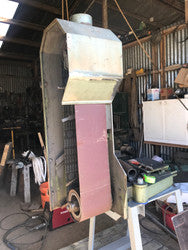Custom Made Sanding Belts - How We Make Your Perfect Abrasive Belt
Whether you are using a portable belt sander, a home-made machine or a factory linisher, the speed of your sanding, the longevity of the abrasive and the quality of the work will be directly affected by the quality of the belt you use.
The quality of custom made belts can vary greatly, particularly the quality of the joins, which will determine a couple of things:
1/ How flat the belt runs. Does it bounce or jump? An overlapping joint is the cheapest but creates a high point on the belt causing it to 'jump' or bounce as it runs over the work surface.
2/ How strong the joint is, especially under tension. It can be a terrifying experience when a belt snaps. This is especially true when you get a slap from a stray end of 36gt (always wear a minimum of safety glasses).
How we make our custom sanding belts - The correct way
1/ Choose your abrasive - Click Here for more information on choosing the best abrasive for your application.
2/ Confirm your size of the belt - Click Here for How to Measure a Sanding Belt - The 5 Step Fool Proof Method.

3/ Measure and Cut - All our abrasives come in jumbo rolls which range in widths from 150mm to 405mm. This width determines our minimum order quantity, e.g. a 300mm wide roll will make 6 x 50mm wide belts.
The jumbo roll is fitted to our measuring machine, and the length accurately measured - it is capable of measuring belts accurately up to 10m long.
The material is then cut to length, we use an angle cut, this is an angle that we have tested with 1000's of belts, it's trusted and true.
4/ Choosing the joining tape. Different types of fibreglass tape are used depending on the raw material used.
5/ Preparing the join. The backing of the material is scuffed prior to the glue stage. This scuffing removes a very minor amount of backing, so that once the tape is applied, it lays flat and is not proud.
6/ Special Joining Glue is applied to the backing of the belt and the fibreglass tape. This High Temp 2 Pack Belt Glue is left to dwell for a set amount of time which varies depending on the tape / abrasive being joined.
7/ After the set dwell time, the join is assembled and pressed on a heated hydraulic press. Plates are heated top and bottom. with press pressure varying between 500 and 2500 psi depending on the material. This beds the tape and insures there is no air behind the tape while the glue is curing.
8/ Belts are then left to dry overnight before being slashed to size.
All our custom made belts follow the same procedure, with adherence to quality control a priority. To extend the life of any sanding belt I recommend keeping them in an airtight storage container and away from extreme temperatures including direct sunlight, as these will all contribute to the breakdown of glues over time.
Happy Sanding!
If you have any questions please get in touch Ask Matt
*Originally Posted by Matt Piggin on 31st August 2023

